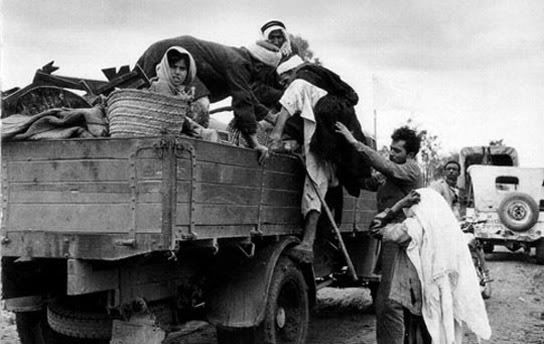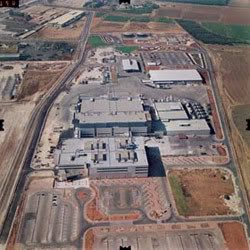
Residents of al-Faluja flee in 1949.
Henry Norr a writer for The Electronic Intifada, on 23 July 2008 reported this interesting story: The Nakba, Intel, and Kiryat Gat, about how the chip maker Intel is contributing to the Nakba, the ethnic cleansing of Palestinians from their homes and lands in 1948-49, how Americans indirectly contribute to Intel’s exploitation of Palestinian lands through our taxes, in short, about how Intel profits from the plight of the Palestinian people in Israel-Palestine.

The photo above reveals residents of al-Faluja, a Palestinian town, fleeing Israeli military in 1949. The photo to the right reveals what al-Faluja is like today: an industrial park largely overrun by Intel factories, now called Kiryat Gat, an Israeli town. Palestinian now Israeli was the fate of many Palestinian villages and town ethnically cleansed in 1948, if they were not bulldozed into the ground.
Intel’s new facility, known as Fab 28, is the largest private-sector investment ever made in Israel: the company has sunk $3 billion into it, and the Israeli government (USA taxpayers) kicked in another $525 million. Since the groundbreaking 28 months ago, it’s been the biggest construction project in Israel — this side of the apartheid wall, that is.
The history of this now Intel dominated town is interesting and Norr provided the full story in his article. This is just an abbreviated version.
Sixty years ago, there was no Kiryat Gat. The land it now occupies was divided between two Palestinian villages, al-Faluja and ‘Iraq al-Manshiya. While the area is well within the Green Line, Israel’s 1949-67 border, its history is in one way unique: Israeli forces never captured it during the 1948-49 war. Egyptian forces occupied it in late May 1948, and although later Israeli counter-offensives broke up their front and laid siege to the two villages — known at the time as the “Faluja pocket” — the 4,000 Egyptian troops deployed there (including a young officer named Gamal Abdel Nasser, soon to become president of his country) held out until Egypt and Israel agreed to an armistice on 24 February 1949.
That’s when the Nakba befell al-Faluja and ‘Iraq al-Manshiya.
Stranded and surrounded, the Egyptians were in no position to stay in the area. To their credit, however, they insisted as a condition of their withdrawal that Israel guarantee the safety of the civilians in the area — about 2,000 locals and some 1,100 refugees from other parts of Palestine.
In principle, Israel accepted the Egyptians’ demand. In an exchange of letters that were filed with the United Nations and appended to the main armistice agreement, the two governments agreed that civilians who wished to remain in al-Faluja and ‘Iraq al-Manshiya would be permitted to do so, and that “All of these civilians shall be fully secure in their persons, abodes, property and personal effects.”
Within days, however, it was clear that the agreement wasn’t worth the paper it was written on. Under the direction of Yitzhak Rabin (later Prime Minister of Israel), and probably with the direct approval of founding Prime Minister David Ben-Gurion, according to historian Benny Morris, Israeli troops promptly mounted “a short, sharp, well-orchestrated campaign of low-key violence and psychological warfare designed to intimidate the inhabitants into flight.”
(snip)
Members of an American Quaker relief mission who were in the area at the time kept a diary detailing the violence they observed, such as the case of a man brought to them with “two bloody eyes, a torn ear, and a face pounded until it was blue.” And UN observers reporting to Ralph Bunche, the distinguished African-American diplomat then serving as chief UN mediator in Palestine, noted not only beatings and robberies, but also cases of attempted rape and “promiscuous firing” on civilians by Israeli soldiers. (Bunche, who won the 1950 Nobel Peace Prize for his efforts, had assumed the chief mediator’s post a few months earlier, after the assassination of his predecessor, the Swedish Count Folke Bernadotte, by a Jewish terrorist organization led by Yitzhak Shamir, also a later prime minister of Israel.)
(snip)
Sharett (the Israeli PM) objected not only to the overt violence, but also to what he said was a “whispering propaganda campaign” conducted covertly by the Israeli army, threatening the civilians with “attacks and acts of vengeance by the army” if they didn’t leave the area. “This whispering propaganda is not being done of itself,” Sharett continued. “There is no doubt that here there is a calculated action aimed at increasing the number of those going to the Hebron Hills [then controlled by Jordan] as if of their own free will, and, if possible, to bring about the evacuation of the whole civilian population” of the Faluja pocket.
Whether Sharett’s concerns had any moderating influence on the army’s behavior isn’t clear, but they certainly didn’t change the outcome. By mid-March all of al-Faluja’s residents had abandoned their homes; the residents of ‘Iraq al-Manshiya held out longer, but after several shootings by Israeli sentries, the last of them — some 1,160 people — left in Red Cross-organized convoys on 21 and 22 April.
Five days later, Rabin ordered the demolition of both villages.
In sum, al-Faluja was ethnically cleansed. Norr continues:
Initially, Kiryat Gat’s major industries were agriculture and textiles. But in the mid-1990s Intel, which had established other facilities in Israel beginning in 1974, chose Kiryat Gat as the site for a huge new plant it called Fab 18. (“Fab” is chip-industry lingo for a facility where semiconductors are fabricated.) Intel put in $1 billion — at the time the largest foreign investment ever in Israel — and it persuaded the Israeli government (via US taxpayer dollars) to contribute another $600 million to build and equip the plant.
Meanwhile, Fab 28 has been going up next door. For the future, an Intel executive last year told reporters that the company was already planning a third Fab plant in Kiryat Gat. In his speech at the 1 July dedication, Olmert said that his government was prepared to offer Intel Israel another $1 billion in grants. Hey, when you have the US contributing 3 billion a year in aid, plus another 3 billion in military equipment, what’s the problem?
As for the rightful owners of the land Intel now occupies, one recent analysis reported that 14,345 refugees from ‘Iraq al-Manshiya (including the descendants of those expelled in 1949) were registered with UNRWA, the UN agency for Palestinian refugees; of these more than 9,000 were living in Jordan, more than 5,000 in the West Bank, several dozen in the US, and others scattered around the world. From al-Faluja, a 1998 estimate put the total number of refugees at 33,267.
Henry Norr covered Intel as a technology reporter and columnist for the San Francisco Chronicle until he was fired in 2003, after writing a column about Kiryat Gat and getting arrested in a demonstration the day the US invaded Iraq. So please don’t tell us the role of the Israel Lobby in the US is minimal. The tail of the dog is still being wagged.




